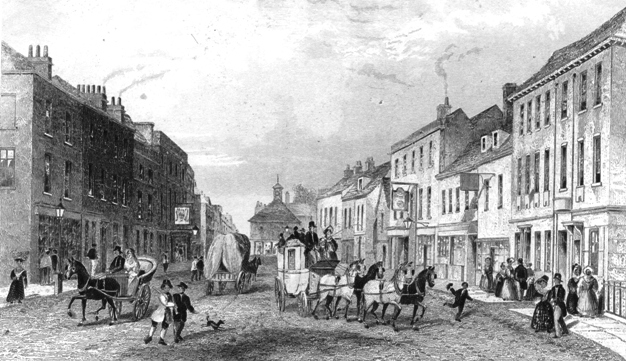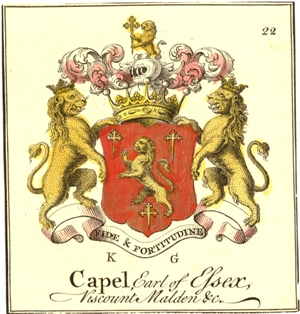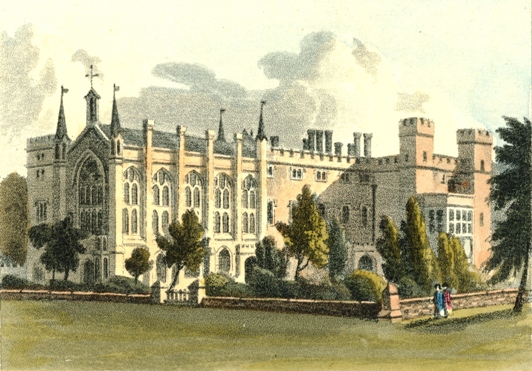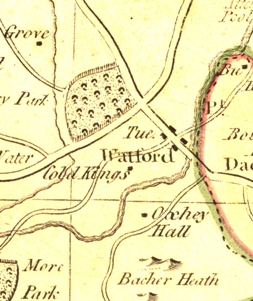
from Dugdale's England and Wales Deliniated
PREVIOUS
to the Conquest, Watford formed part of
Caishoe,
or
Cashio,
and, included under that appellation, was given by King Offa to the Abbey of St. Alban, to which it continued attached till the time of the Dissolution, when the Stewardship of this, and other adjacent manors, was given to John, Lord Russel, of Chenies, in Buckinghamshire. James the First, in the seventh of his reign, granted Watford to the Lord Chancellor Egerton, Baron of Ellesmere, in whose descendants, the Dukes of Bridgewater, it :remained rested till about the year 1760, when it was sold to the
then Earl of Essex, and is now the property of his descendant, the present Earl.
The Abbots of St Alban's had various privileges granted to them for this manor, by different Sovereigns: the charter of the market was bestowed by Henry the First; and Edward the Fourth gave them liberty to hold two fairs annually. The Market-House is a long building, rough-cast above, and supported on wooden pillars beneath. The quantity of corn sold here is very great; and the number of sheep, cows, calves, hogs, &c. is proportionable. The police of the town is under the direction of resident and neighbouring magistrates.
The Church is a very spacious building, dedicated to the Virgin Mary, and consists of a nave, aisles, and chancel, with a massive embattled tower at the west end, about eighty feet high, terminated by a small spire, rising to the height of about twenty more. The nave is divided from the aisles by six pointed arches on each side, with plain mouldings, resting on octagonal columns; above the arches are the same number of obtuse-headed windows. The roof is of a circular form; the supporters rest on half figures, sustaining shields. The chancel, which appears of a more recent date than the nave, opens from the latter by a large pointed arch. The east window is divided by mullions into several compartments; but the light is obscured by a large altar-piece of oak, carved in the style of James the Second's time.

Cashiobury: from Hassell's
Picturesque Rides and Walks
On the north side of the chancel is the Chapel, or Cemetery, of the Morisons, and now of the Essex family. This contains, among others of inferior execution, two very fine monuments, by Nicholas Stone. The first, which is erected against the south wall, is a stately fabric, in memory of SIR CHARLES MORISON, Knt, of Cashiobury, who died in his fifty-first year, in March, 1599. The upper and central part consists of a pediment and canopy, resting on Corinthian pillars: below the canopy is the effigies of Sir Charles in white marble. He is represented as a Knight in armour, in a recumbent position, with his elbow resting on a cushion, and one hand Oil the pommel of his sword. His beard is in the Vandyke fashion; whiskers on his upper lip; and about his neck, a large ruff. Loose, but standing behind his legs, is a helmet, with a plume of feathers; and above him is a Latin inscription in two compartments. In front of the tomb is another inscription, similarly disposed; and under the cornice of the canopy are the words, Non Humi serpit alata Virtus. At each end, under a canopy of flowing drapery, dependant from a ring, is a figure kneeling on a cushion. These represent the son and daughter of Sir Charles: the former is habited as a Knight, with a sash, ruff, peaked beard, and whiskers: the lady has a ruff also, and has on a long cloak fastened over the breast by a cordon, which is tied across the middle, and hangs down in tassels.
This monument, as appears from the pocket-book of Nicholas Stone, quoted by Walpole, cost £260. besides " our pieces," says the sculptor, "given me to drink." The Latin inscriptions are to the following import. To the virtue, honour, and immortal memory, of the dearest and most respected man SIR CHARLES MORISON, Knt. hereditary Impropriator of this Church, and Founder of this Chapel, the most be loved and best of Fathers; Charles Morison, Knt. and Bart. a most affectionate Son, piously and reverently dedicated this Monument, the last duty of love and devotion, to a very deserving and accomplished Parent, in the most certain hope of a glorious and blessed Resurrection. He married Dorothy, the daughter of Nicholas Clark, Esq. by whom he had two children, now living; Charles, above mentioned, an only son; and Bridget, an only daughter, betrothed to the most noble Robert, Earl of Sussex. He died on the 30th of March, 1599, in the Fifty-first Year of his Age. His Father, Sir Richard Morison, Knt. the most generous of Men, was skilled in all the more noble branches of Literature; and in many Embassies to the German Emperors, and other Christian Princes, he executed his trust with the greatest renown. His Mother, the illustrious Lady Bridget, daughter of John, Lord Hussey, became by marriage Countess of Rutland, and afterwards of Bedford.
The other monument of Stone's workmanship, is on the opposite side, against the north wall: this was erected in memory of SIR CHARLES MORISON, Bart. and Knight of the Bath, son of the above Sir Charles, by MARY his lady, second daughter of Baptist Hicks, Viscount Campden. In its general form it is similar to the former: the canopy is supported by Corinthian pillars of black marble, with wreaths of flowers below the capitals. On the tomb beneath, are the figures of the Baronet and his Lady, in white marble, most exquisitely sculptured. The former, who is represented in armour, is reclining on his side, his right elbow resting on a cushion, and his hand placed on a skull: he has a peaked beard, and whiskers. His lady is lying recumbent, with her head on a double cushion, and has on a veil, turned back over her forehead: round her neck is a ruff. Her sleeves are purfied; and one hand holds an outward robe, which is fastened to her boddice by a diamond-headed pin. The folds of the drapery, which envelopes her feet, are very finely managed. She has a smiling countenance; that of the Baronet is more composed and thoughtful. At the east side, on a lower base, are the figures of a youth, and a boy, kneeling on cushions: both have ruffs; and the former an outward cloak, and a sword. At the west side is a young lady, also kneeling on a cushion, with flowing drapery, extending behind her head, and brought up and fastened over her left breast by a diamond broach; round her neck, a ruff: her hands are broken off, but have been raised as in prayer. The inscriptions are in Latin, and very long. Sir Charles died in April, 1028, about a week after he had completed his forty-first year. The expense of executing this monument was £400.
In the middle of the cemetery are two large tombs with effigies, both deserving notice, though not so finely wrought as those that have been described. That towards the east was erected in memory of the Lady BRIDGET, Countess Dowagcr of Bedford, who died at the age of seventy-five, in January, 1600. Her figure, well sculptured in alabaster, lies on the tomb; the head resting on an ornamented cushion; and between the feet a fruit-tree, with a rein-deer below. Round her neck is a ruff; on her head a close cap, and coronet. She has on a large loose cloak, reaching to her feet, and fastened across her bosom: the hands are broken off, but have been raised as in prayer. From the side of the tomb, the base is carried out in a square projection; and on each is a half-sized male figure in armour, kneeling on a cushion. Round the tomb are various shields of arms; and at the east end a long inscription in memory of the Countess.
Part of this is as follows. "She was daughter of John, Lord Hussey, and was thrice married: first to Sir Richard Morizon, Knt. then to Edward Manners, Earl of Rutland: thirdly, to Francys Russel, Earl of Bedford: she had issue only by her first husband, one son, Sir Charles Morizon, Knt. and two daughters; the one named lane Sibilla, first married to Edward, Lord Russel, eldest son to her last husband, the Earl of Bedford; and afterwards married to Arthur, Lord Grey of Wilton, father to Thomas, Lord Grey: the other daughter, named Elizabeth, was first married to William Norreys, Esq. Son and heir apparent to Henry, Lord Norreys, and father to Francys the nowe Lord Norreys, at whose charges this Monument was erected, being her sole executor and nephewe; who hath married the Lady Bridget Vere, daughter to Edward, Earl of Oxford ; - afterwards Elizabeth, the second daughter, married Henry Clinton, Earl of Lincoln."
The westernmost tomb commemorates the virtues of "The Right Honorable Lady DAME ELIZABETH RUSSELL, daughter and sole heire of Henrie Longe, of Shillgay," in Cambridgeshire, and wife of William, Lord Russell, of Thornhaugh, son of Francis, Earl of Bedford: she died at the age of forty-three, in June, 1611. Her figure is represented in a very heavy long cloak and petticoat, with a close boddice buttoned down the middle. Her head rests on a cushion, which, as well as the face, and the whole dress, has been painted: at her feet is a coronet and lion.
Among the other memorials here, are two Tablets against the south wall; one of these records the character and memory of The HONORABLE JOHN FORBES, second son of George, third Earl of Granard, Admiral of the Fleet, and General of Marines, who died at the age of eighty-two, in March, 1769: the other is in commemoration of his Lady, 'the Right Honorable MARY FORBES, daughter of William, third Earl of Essex, by the Lady June Hyde, daughter of Henry, fourth Earl of Clarendon, and second Earl of Rochester.' WILLIAM ANNE-HOLLES CAPEL, son of the above William, and fourth Earl of Essex, was also buried in this cernetary in March, 1799, as appears by the Register; though no memorial has been erected to his memory. On a slab of breccia, in the pavement, are figures in Brass of three servants to the Morisons, in dresses of the time of James the First.
In the nave and aisles of the Church, are many other Sepulchral memorials: several of the Ewers, of the Lea, in this parish, are interred below the altar steps; and in the south aisle are slabs ill memory of Sir William Buck, Bart. who died in August, 1717, aged sixty-two; Frances, his daughter, who died at the age of thirty-one, in November, 1713; and Sir Charles Buck, Bart. his son, who died in June, 1729, at the age of thirty-seven. The following epitaph, which appears on a tablet of white marble on the south wall of the nave, was written by Dr. Johnson,
|
In the Vault below are deposited the Remains of |
This Church is crowded with pews and galleries: the organ gallery is very large, and supported on four Corinthian columns; the organ is well-toned. At the east end of the south aisle, are tablets, registering numerous benefactions that have been made for the use of the poor, &c. of this parish.
At the south side of the Church-yard is a good Free School, of brick, with convenient apartments for a Master and Mistress. This was founded and endowed by MRS. ELIZABETH FULLER, of Watford Place, (which nearly adjoins the School,) in the year 1704, for forty boys and twenty girls, who are partly clothed, and taught reading, writing, and arithmetic. The original endowments have been increased by some additional legacies. The government of the School is vested in nine trustees, who are chosen from the most respectable inhabitants of Watford, a preference being given to the kindred of the Foundress, a full-length portrait of whom is preserved in the School Room. This was painted by J. Woolaston, and has the date 1708: she is represented in widow's weeds, with the Scriptures lying open by her side, and her right hand pointing to a label, with the words, 'Daily read and practice the Holy Bible.' Her countenance expresses a calm and placid benignity.

from Hassell's
Walks
|
|
Watford is a large, populous, and busy town; the houses are principally of brick; many of them are respectable and handsome buildings; they principally range on the sides of the high road, and extend in a north-westerly direction rather more than a mile. The chief employment of the laboring classes is derived from agriculture; but additional labor is furnished by the throwing of Silk, three Silk Mills having been established in and near the town. The largest Mill is worked by the waters of the Colue river; but the others are worked by horses. The population of Watford, as ascertained under the late Act, was 3530; the number of houses was 691.
More detailed map of Watford in 1800.
For a later account see Watford in 1880

